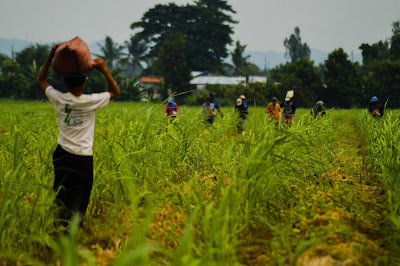The different faces of child labor in Eastern Visayas
In one hot afternoon, children ages 10-14 years old were seen working in the sugarcane plantations in one of the haciendas in Ormoc City. They wear a pair of old socks and slippers, long sleeves and a piece of cloth that protects their heads against the heat of the sun, as their daily protection in working in the sugarcane plantations.
The 13-year-old, Pauline (not her real name), has her own “machete” (the sharp bolo that is used for the cleaning of the sugarcane plant). She spent the whole summer season working in the field and was paid for 110 a day. Her father was a construction worker while her mother is a housekeeper. Her mother can’t work because she had undergone a caesarean operation when she gave birth to her third child.
She is a grade six pupil at Cagbunhangin Elementary School in Ormoc City. She admitted that there were days that she has to leave her class in school because she has to help his father to earn money for their food. All her money she earned from working in the plantation was given to her parents.
Most of the time, she went to school without money for her snacks during their break time.
“Kadalasan wala po akong baon, ibinibigay kop o kasi sa mga magulang ko ang kinikita ko para sa pambili ng pagkain namin,” said Pauline.
Working in the sugarcane plantations has never been easy for them, they admitted.
“Mahirap, mainit, marami akong sugat dito sa kamay at sa paa. Napapagod na ako. Wala naman po kaming magawa, gusto ko pong tulungan ang pamilya ko,”she added.
The young Pauline dreamed to become a caregiver someday and work abroad.
Like her, Jose (not his real name) 11 years old, was also determined in finishing his studies. He was also one of the child workers in the plantation. His father was a former sugarcane farmer and had just retired years ago because of his old age. His mother also works in the field. Until now, their house that has been destroyed by typhoon Yolanda remained unrepaired. His family, like other families in their Brgys was still waiting for the Emergency Shelter Assistance of the DSWD.
Jose started working in the plantation at the age of 10. He worked in the field three days a week, sometimes if he needs to. When asked for the reason for his determination in pursuing his studies despite the hardships they experience, he said that it is because he wanted to work in a bank someday.
“Gusto ko magtrabaho sa bangko, kasi maraming pera,” he said with a smile.
“Mga batang graba of Northern Samar”
In the province of Northern Samar, where a large number of child labor case has been recorded, particularly in Brgy San Juan in the municipality of San Isidro, children spent their summer vacation helping their parents work in the quarry site along the National Highway. This is to augment their income to support their daily needs and for their education.
Children ages 7-13 years old in the quarry sites were seen smashing a medium-sized rock to make it into small pieces of gravel to be sold later to some contractors for 13 pesos per sack.
From six o’clock in the morning, children together with more than 25 families whose daily expenses depends on the sale of gravel were already in line to start their day by smashing pieces of rocks taken from the rock mountain across the street where they worked.
Jovelyn Lacandazo, 33 y/o, a mother of three, agreed that the children were working in a risky environment but they have no choice but to let them help because they need to have more income in a day to cover their daily expenses.
“Oo delikado, syempre. Hindi lang sa mga bata kundi sa mga matatanda rin tulad namin. Kasi maraming beses nang napukpuk yung mga daliri ko at napuwing ng maliliit na bahagi ng bato ang aking mga mata. Eh sa mga bata pa kaya, Dyos na ang bahala sa amin,” Lacandazo said.
Marilyn (not her real name), 13 years old, works every day in the quarry site to earn some pesos in preparation for her schooling this June. She wants to be a teacher someday.
Her parents are farming a small portion of land located few kilometers away from their Brgy.
Joseph, 12 y/o have been doing his work since he was 7 y/o. At the age of 12, the kid was still in his third grade. He had to stop his schooling for some time to prioritize helping her mother in their livelihood for them to have food on their table. At his age, his young body already shows his tired muscles.
With the combination of their efforts, they can provide five sacks in a maximum for one day. But there were times that no one of their regular contractors buys their gravel.
“Minsan kasi walang pambaon ang mga bata, kaya yun dito sila nagtatrabaho. Minsan piso pag may pera kami,” said Lacandazo.
When asked on what he wanted to become in the future, he whispered “gusto ko maging seaman”. While his brother Jayvee, 8 y/o wanted to become a soldier.
They both help their mother working in the quarry site to have an additional income which they will save for their schooling this June.
Instead of playing during Saturdays and Sundays, children were seen working the whole day for 13 pesos.
Government intervention
Last 2013, the Department of Labor and Employment implemented a four-year program to minimize the child labor cases in the Brgys of Eastern Visayas.
The office recorded the existence of child labor in 22 Brgys in the towns of Mondragon, Catarman, Laoang and Las Navas in Northern Samar as well as in Tacloban City and Ormoc City in Leyte.
The four-year program aims to save at least 75% of 213,000 young workers in the region. Of the total, 159,750 are engaged in hazardous work.
The four-year program aims to save at least 75% of 213,000 young workers in the region. Of the total, 159,750 are engaged in hazardous work.
Their assessment showed that children in the region are engaged in pedicab driving, child trafficking, child prostitution, domestic work, farm labor, quarrying, garbage collection, deep-sea fishing, passenger vehicle and motorboat crew, and vending.
Meanwhile, in an interview with Nia Chua Child Labor focal person of DOLE-8, there was an increase of numbers of child labor cases a year after Haiyan. From 22 brgys recorded last 2013 it increased to 25 brgys in the region.
Of the six provinces in the region the province of Northern Samar, which has been considered as one of the poorest province in the country, 14 brgys were recorded to have an existing child labor cases.
The second on the list is Leyte particularly in Ormoc City where big haciendas are located.
The Brgys of Dayhagan, Juanton, Maticaa and Dolores in Ormoc City has an existing child labor cases which are usually children were working in the sugar plantations. The authorities also cited the existence of child labor cases in the Poblacions in the provinces of Southern Leyte, Samar, Eastern Samar and Biliran.
In Tacloban City, child labor cases were recorded from the four biggest Brgy namely Brgy 37, Seawall District, Brgy 106 Sto Nino, Brgy 1 and 4 which is located near the port area.
“Not only the DOLE has the sole responsibility of this cases, kasama din po namin dito sa campaign na ito yung DILG, DepEd, DILG, DSWD and even the DOJ,” said Chua.
There were interventions designed for the livelihoods of the parents whose children were working in a risky environment.
June 12 was marked as the World Day against Child Labor with its theme “No to child labor, yes to education”.
Child labor victims from Eastern Samar rescued in Cebu
Recently, there were two minors who came from Balanginga, Eastern Samar were rescued by the authorities, who were working in a construction site in Cebu City.
According to Nia Chua, Child Labor focal person of the Department of Labor and Employment, the two minors fled to Cebu City last 2014 after typhoon Yolanda hit Eastern Visayas.
In Cebu City, the employer hired the minors in a masonry job and was paid below the minimum wage. They were prompted to accept the job offer because of the difficulty of the situation their families were facing after the disaster.
The DOLE Region 7 coordinated with the DOLE Region 8 to send them back to their families in Balanginga, Eastern Samar.
“Basta yung pagkakaalam ko base doon sa mga bata ay nagtrabaho sila sa Cebu ng sobrang hirap ng sitwasyon nila matapos ang Yolanda,” Chua added. [END]









Tsk.. Tsk.. Tsk..
ReplyDelete